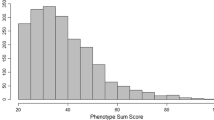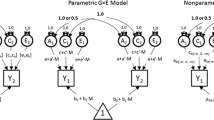Abstract
Investigating genotype by environment interactions (GxE) is generally considered challenging due to the scale dependency of the interaction effect. The present paper illustrates the problems associated with testing for GxEs on summed item scores within the well-known ACE model. That is, it is shown how genuine GxEs may be masked and how spurious interactions can arise from scaling issues in the data. A solution is proposed which explicitly distinguishes between a measurement model for the ordinal item responses and a biometric model in which the GxE effects are investigated. The new approach is studied in a simulation study using both a scenario in which the measurement instrument suffers from mild scaling problems and a scenario in which the measurement instrument suffers from severe scaling problems. Results indicate that the severity of the scale problems affects the power to detect GxE, but it rarely results in false positives. We illustrate the new approach on a real dataset concerning affect.





Similar content being viewed by others
Notes
The work by Schwabe and van den Berg (2014) was conducted parallel to—but independent from—the present undertaking. Only at a late stage did we learn about each others work on this topic.
The cumulative standard normal distribution function, Φ(.), in Eq. 5 assumes unit polychoric variances of the item scores conditional on θp1 and θp2. Due to the presence of δpi, the conditional polychoric variance will depart from 1 if r i ≠ 0. Therefore, to prevent parameter bias, the scaling term is added to ensure that the conditional polychoric variance will be equal to 1.
The opinions expressed in this article are those of the authors and do not necessarily reflect the views of the ICPSR.
Because we used a Bayesian model fit approach, we omitted the term ‘power’ in discussion of the results and spoke of ‘hit rate’ instead. However, to be able to compare results of the frequentist results we take the ‘hit rate’ as found in present study as an indication for what the ‘power’ would have been when we would have implemented present model in a frequentist framework.
References
Bauer DJ, Hussong AM (2009) Psychometric approaches for developing commensurate measures across independent studies: traditional and new models. Psychol Methods 14:101–125
Birnbaum A (1968) Some latent trait models and their use in inferring an examinee’s ability. In: Lord EM, Novick MR (eds) Statistical theories of mental test scores, vol 17–20. Addison Wesley, Reading
Bock RD, Aitkin M (1981) Marginal maximum likelihood estimation of item parameters: application of an EM algorithm. Psychometrika 46:443–459
Boker S, Neale MC, Maes HH, Wilde M, Spiegel M, Brick T et al (2010) OpenMx: an open source extended structural equation modeling framework. Psychometrika 76:306–317
Brim OG, Baltes PB, Bumpass LL, Cleary PD, Featherman DL, Hazzard WR et al (2010) National Survey of Midlife Development in the United States (MIDUS), 1995–1996. Inter-university Consortium for Political and Social Research, Ann Arbor, MI
Curtis SM (2010) BUGS code for item response theory. J Stat Softw 36(1):1–34
Dolan CV (1994) Factor analysis of variables with 2, 3, 5 and 7 response categories: a comparison of categorical variable estimators using simulated data. Br J Math Stat Psychol 47:309–326
Dolan CV, van den Berg SM (2008) Power analysis. In: Neale, et al. (eds) Statistical genetics: gene mapping through linkage and association. Taylor & Francis, London
Eaves LJ (1977) Inferring the causes of human variation. J R Stat Soc A 140:324–355
Eaves LJ (2006) Genotype x environment interaction in psychopathology: fact or artifact? Twin Res Human Genet 9:1–8
Eaves LJ, Erkanli A (2003) Markov chain Monte Carlo approaches to analysis of genetic and environmental components of human developmental change and GxE interaction. Behav Genet 33:279–299
Eaves LJ, Last K, Martin NG, Jinks JL (1977) A progressive approach to non-additivity and genotype-environmental covariance in the analysis of human differences. Br J Math Stat Psychol 30:1–42
Evans DM, Gillespie NA, Martin NG (2002) Biometrical genetics. Biol Psychol 1–2:33–51
Gelman A, Rubin DB (1992) Inference from iterative simulation using multiple sequences. Stat Sci 7:457–511
Geman S, Geman D (1984) Stochastic relaxation, Gibbs distributions, and the Bayesian restoration of images. IEEE Trans Pattern Anal Mach Intell 6:721–741
Hessen DJ, Dolan CV (2009) Heteroscedastic one-factor models and marginal maximum likelihood estimation. Br J Math Stat Psychol 62:57–77
Jinks JL, Fulker DW (1970) Comparison of the biometrical genetical, mava, and classical approaches to the analysis of human behavior. Psychol Bull 73:311–349
Johnson W, Krueger RF (2005) Genetic effects on physical health: lower at higher income levels. Behav Genet 35:579–590
Kamin L (1974) The sciencs and politics of IQ. Erlbaum, Potomac
Lau JYF, Eley TC (2008) Disentangling gene-environment correlations and interactions on adolescent depressive symptoms. J Child Psychol Psychiatry 49:142–150
Loftus GR (1978) On interpretation of interactions. Mem Cognit 6:312–319
Lunn DJ, Thomas A, Best N, Spiegelhalter D (2000) WinBUGS—a Bayesian modeling framework: concepts, structure, and extensibility. Stat Comput 10:325–337
Lunn D, Spiegelhalter D, Thomas A, Best N (2009) The BUGS project: evolution, critique, and future directions. Stat Med 28:3049–3067
Martin NG, Eaves LJ, Kearsey MJ, Mavies P (1978) The power of the classical twin design. Heredity 40:97–116
Mather K, Jinks JL (1971) Biometrical genetica: the study of continous variation. Chapman & Hall, London
Medland SE, Neale MC, Eaves LJ, Neale BM (2009) A note on the parameterization of Purcell’s GxE model for ordinal and binary data. Behav Genet 39:220–229
Miles DR, Silberg JL, Pickens RW, Eaves LJ (2005) Familial influences on alcohol use in adolescent female twins: testing for genetic and environmental interactions. J Stud Alcohol 66:445–451
Molenaar PCM, Boomsma DI (1987) Application of nonlinear factor-analysis to genotype environment interaction. Behav Genet 17:71–80
Molenaar D, Borsboom D (2013) The formalization of fairness: issues in testing for measurement invariance using subtest scores. Educ Res Eval 19:223–244
Molenaar D, van der Sluis S, Boomsma DI, Dolan CV (2012) Detecting specific genotype by environment interactions using marginal maximum likelihood estimation in the classical twin design. Behav Genet 42:483–499
Molenaar D, van der Sluis S, Boomsma DI, Haworth CM, Hewitt JK, Martin NG et al (2013) Genotype by environment interactions in cognitive ability: a survey of 14 studies from four countries covering four age groups. Behav Genet 43:208–219
Mroczek DK, Kolarz CM (1998) The effect of age on positive and negative affect: a developmental perspective on happiness. J Pers Soc Psychol 75(5):1333–1349
Neale MC, Cardon LR (1992) Methodology for genetic studies of twins and families. Kluwer Academic, Dordrecht
Neale MC, Boker SM, Xie G, Maes HH (2006) Mx: statistical modeling, 7th edn. Department of Psychiatry, VCU, Richmond
Plummer M (2003) JAGS: a program for analysis of Bayesian graphical models using Gibbs sampling. Proceedings of the 3rd international workshop on distributed statistical computing (DSC 2003), pp 20–22
Plummer M, Best N, Cowles K, Vines K (2005) CODA: output analysis and diagnostics for MCMC. R package version 0.9–2
Purcell S (2002) Variance components models for gene-environment interaction in twin analysis. Twin Res 5:554–571
Rasch G (1960) Probabilistic models for some intelligence and attainment tests. Danmarks Paedogogiske Institut, Copenhagen
Rathouz PJ, van Hulle CA, Rodgers JL, Waldman ID, Lahey BB (2008) Specification, testing, and interpretation of gene-by-measured-environment models in the presence of gene environment correlation. Behav Genet 38:301–315
Samejima F (1969) Estimation of ability using a response pattern of graded scores. Psychometrika Monograph 17:253
Saris WE, Satorra A (1993) Power evaluations in structural equation models. In: Bollen KA, Long JS (eds) Testing structural equation models. Sage, Newbury Park, pp 181–204
SAS Institute (2011) SAS/STAT 9.3 user’s guide. SAS Institute, Cary
Satorra A, Saris WE (1985) The power of the likelihood ratio test in covariance structure analysis. Psychometrika 50:83–90
Schwabe I, van den Berg SM (2014) Assessing genotype by environment interaction in case of heterogeneous measurement error. Behav Genet. doi:10.1007/s10519-014-9649-7
Spearman CE (1927) The abilities of man: their nature and measurement. Macmillan, New York
Tucker-Drob EM (2009) Differentiation of cognitive abilities across the life span. Dev Psychol 45:1097–1118
Tucker-Drob EM, Harden KP, Turkheimer E (2009) Combining nonlinear biometric and psychometric models of cognitive abilities. Behav Genet 39:461–471
Turkheimer E, Haley A, Waldorn M, D’Onofrio B, Gottesman II (2003) Socioeconomic status modifies heritability of IQ in young children. Psychol Sci 14:623–628
Turkheimer E, Harden KP, D’Onofrio B, Gottesman II (2009) The Scarr Rowe interaction between measured socioeconomic status and the heritability of cognitive ability. In: McCartney K, Weinberg RA (eds) Experience and development: a festschrift in honor of Sandra Wood Scarr. Psychology Press, New York, pp 81–97
van den Berg SM, Beem L, Boomsma DI (2006) Fitting genetic models using Markov chain Monte Carlo algorithms with BUGS. Twin Res Human Genet 9:334–342
van den Berg SM, Glas CA, Boomsma DI (2007) Variance decomposition using an IRT measurement model. Behav Genet 37:604–616
van der Sluis S, Dolan CV, Neale MC, Boomsma DI, Posthuma D (2006) Detecting genotype-environment interaction in monozygotic twin data: comparing the Jinks & Fulker test and a new test based on marginal maximum likelihood estimation. Twin Res Hum Genet 9(3):377–392
van der Sluis S, Posthuma D, Dolan CV (2012) A note on false positives and power in GxE modelling of twin data. Behav Genet 42:170–186
Wagenmakers E-J, Krypotos A-M, Criss AH, Iverson G (2012) On the interpretation of removable interactions: a survey of the field 33 years after Loftus. Mem Cognit 40:145–160
Wirth RJ, Edwards MC (2007) Item factor analysis: current approaches and future directions. Psychol Methods 12:58–79
Zand Scholten A (2011) Admissible statistics from a latent variable perspective. Unpublished doctoral dissertation. University of Amsterdam, Amsterdam
Acknowledgment
Conor V. Dolan is supported by the European Research Council (Genetics of Mental Illness; Grant number: ERC-230374).
Conflict of Interest
Dylan Molenaar and Conor V. Dolan declare that they have no conflict of interest.
Human and Animal Rights and Informed Consent
All procedures followed were in accordance with the ethical standards of the responsible committee on human experimentation (institutional and national) and with the Helsinki Declaration of 1975, as revised in 2000 (5). Informed consent was obtained from all patients for being included in the study. As we analyse data that was administered in the National Survey of Midlife Development in the United States (MIDUS) in 1995–1996 under the auspices of the Inter-university Consortium for Political and Social Research (ICPSR), we kindly refer to this source for details concerning ethical procedures and informed consent.
Author information
Authors and Affiliations
Corresponding author
Appendices
Appendix A: OpenBUGS code to fit the model in case of dichotomous item scores

Appendix B: OpenBUGS code to fit the model in case of Likert item scores

Rights and permissions
About this article
Cite this article
Molenaar, D., Dolan, C.V. Testing Systematic Genotype by Environment Interactions Using Item Level Data. Behav Genet 44, 212–231 (2014). https://doi.org/10.1007/s10519-014-9647-9
Received:
Accepted:
Published:
Issue Date:
DOI: https://doi.org/10.1007/s10519-014-9647-9




